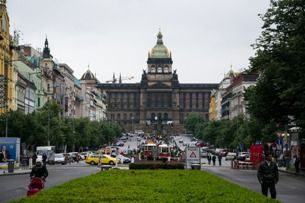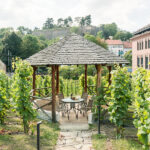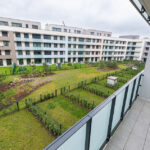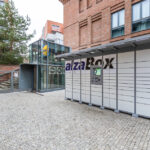Start looking around Wenceslas Square in style and let’s meet “under the horse”. You might even see a gathering or demonstration there… Wenceslas Square has been the place of key moments in the modern history of Prague: political regimes changed and important statements were made there.
Let’s meet “under the tail”
You might have heard this phrase; Praguers use it quite often. The equestrian statue of St. Wenceslas, dominating the upper part of Wenceslas Square, is the point of most dates and meetings in the centre of Prague.
The bronze sculpture group of Wenceslas and four other patrons of the Czech lands has been the symbol of statehood and the nation’s pride for more than hundred years. Designed by Josef Václav Myslbek and depicting the saint in the role of warrior, its project won in the competition of seven other sculptors. Myslbek worked on the sculpture for more than thirty years.
The ceremonial unveiling of the monument took place in 1913 and at that time, the sculpture included St. Wenceslas and only three patrons – St. Prokop, St. Agnes and St. Ludmila. In 1924, the fourth corner of the massive pedestal was completed with the statue of St. Adalbert.
The place of protests and demonstrations
At St. Wenceslas’s horse, the independent Czechoslovakia was declared a republic in October 28, 1918. The historic date can also be found on the pavement in front of the monument: 28. X. 1918.
The surrounding area serves as a meeting point for various protests and public gatherings even today. At the statue, the student Jan Palach burnt himself to death in 1969 to protest the Soviet occupation. Twenty years later, this was the place where the so-called Velvet Revolution started and made the totalitarian regime fall.
The history of Wenceslas Square
The square, originally called Horse Market, was built according to the decree establishing the New Town of Prague issued in 1348. The business and cultural centre did not get the present name, St. Wenceslas or Wenceslas Square, until 1848 at the instigation of the journalist Karel Havlíček Borovský.
The National Museum in the upper part of the square was built on the site of the Horse Gate, part of the city fortification demolished in walls1875. Today, no one can imagine that Vinohradský stream was flowing down the square to a pond at the lower part of the square. The oblong square didn’t get its paving and electric lighting in the late 19th century.
Wenceslas Square resembles a market even today. During the day, you can visit various shops, stallholders, fast foods, luxury ventures, bars, and department stores. The square and its surroundings are also full of theatres and cinemas. The rush and traffic on Wenceslas Square doesn’t stop even at night although the place is frequented rather by drug dealers and prostitutes than tourists at that time.
How to get there
Wenceslas Square is a traffic hub of the city centre. It is accessible from two transfer metro stations – Můstek (A and B lines) is situated at the lower and middle parts of the square; Muzeum (A and C lines) is at the upper part of the square, below the National Museum and the statue of St. Wenceslas.
Trams used to be in the square until 1980; today, the closest tram stops can be found in Vodičkova Street and at the Henry’s Tower. The return of trams to Wenceslas Square and no entry for cars have been discussed already for some time.
Photo – source: Pixabay.com





